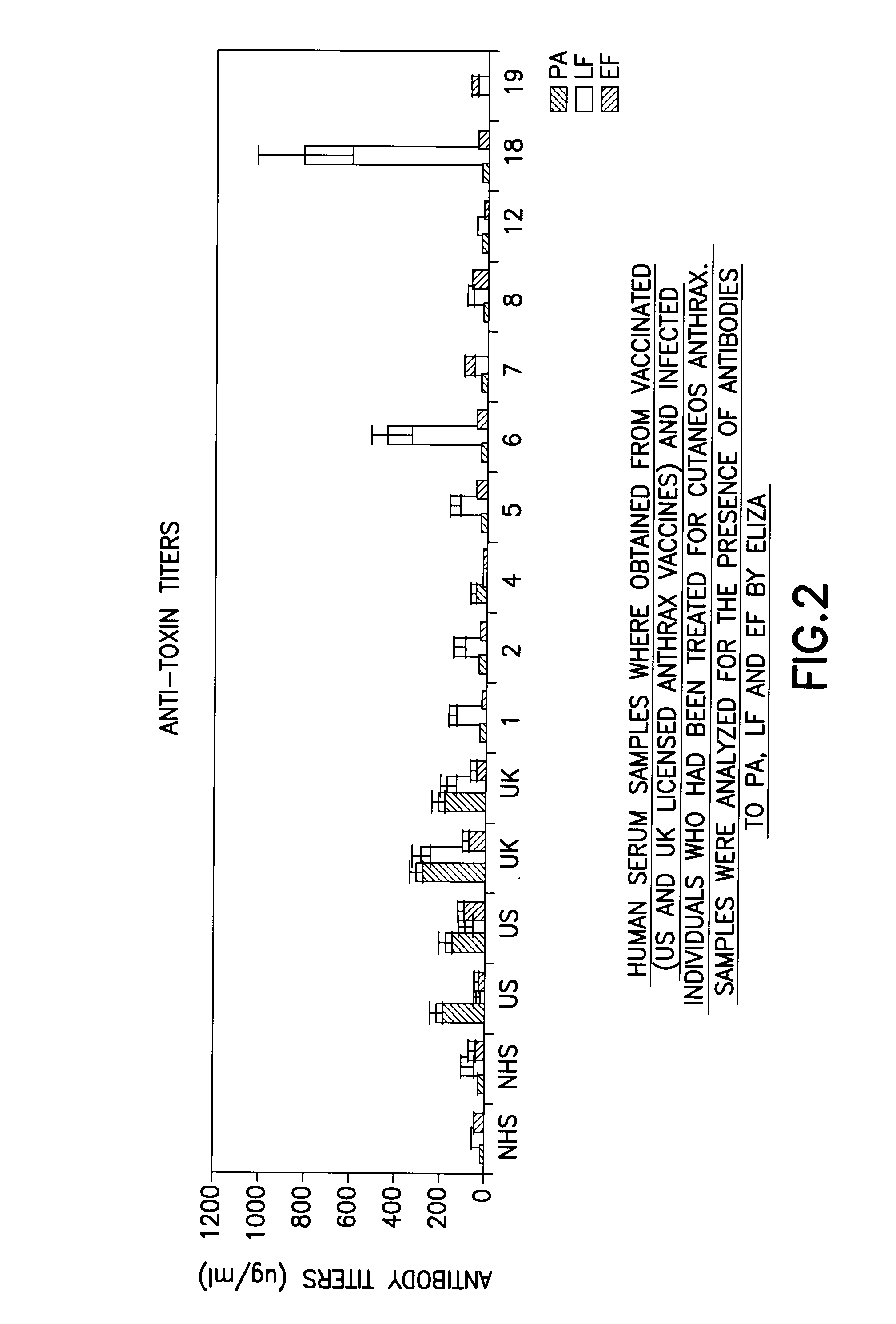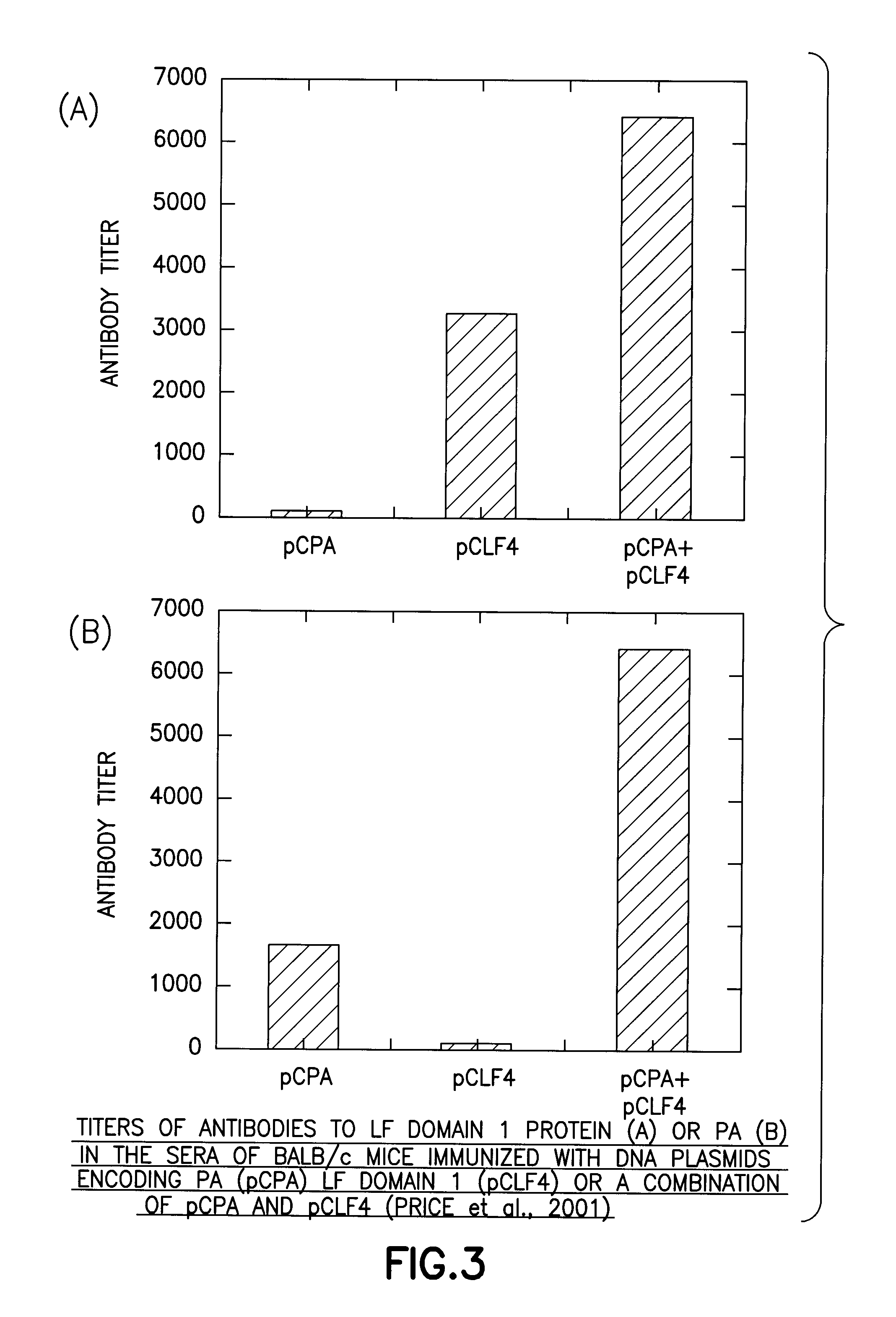Salmonella based oral vaccines for anthrax
an oral vaccine and salmonella technology, applied in the field of salmonella based oral vaccines, can solve the problems of halting the host's immune response, cell death, and human workers working with such animals
- Summary
- Abstract
- Description
- Claims
- Application Information
AI Technical Summary
Benefits of technology
Problems solved by technology
Method used
Image
Examples
example 1
Determination of Immunogenicity of Individual LF Domains
[0122]This example was performed to determine the regions of LF capable of stimulating a protective immune response when given as a vaccine. In order to maximize LF expression in E. coli and Salmonella, the codon usage of the LF gene was optimized, as shown in FIG. 16. The resynthesized gene comprising the mature protein was detoxified, by replacing the glutamic acid at position 687 within the catalytic center with a cysteins (Klimpel, Arora and Leppla, Mol. Microbiol., 1994, 13(6); 1093.). Individual LF domains (see FIG. 5) were cloned and expressed from E. coli M15 (pREP4) using a pQE-30 / pQE-80L, an N-terminal Hist tag expression system (QIAgen, Inc., Valencia, Calif.).
[0123]The immunogenicity of the expressed and purified LF domains was determined in BALB / c mice. Each group, comprising 10 animals, received i.m. 10 ug of domain protein together with the adjuvant alum on days 0 and 28. Animals were bled on days 1, 13, 27, 56 a...
example 2
Toxin Neutralizing Activity by Antibodies Specific to Individual LF Domains
[0124]The ability of the individual expressed and purified LF domains to stimulate toxin neutralizing antibodies was determined in BALB / c mice. Each group, comprising 10 animals, received i.m. 10 ug of domain protein together with the adjuvant alum on days 0 and 28. Animals were bled on days 1, 13, 27, 56 and 72. The LF specific IgG antibody responses were determined by ELISA.
[0125]The ability of antibodies specific to individual LF domains to neutralize toxin activity was determined. The results are set forth in FIG. 9. As can be seen in the figure, full length PA was the most effective at stimulating toxin neutralizing antibodies. Domains 1, 2, 4 and 2-4 showed moderate levels of stimulation of toxin neutralizing antibodies, as did biologically inactive full length LF. Domains 3 and 4 showed no detectable toxin neutralization.
example 3
Determination of Immunogenicity of Individual LF Domains Co-Delivered with PA
[0126]Groups of 10 BALB / c mice were immunized with 10 ug of each protein with PA with alum i.m. on days 0 and 28. Animals were bled on days 1, 13, 27, 56 and 72 and the IgG response to PA and each LF domain was determined by ELISA. FIG. 10 shows the results. Only Domain 3 showed an increase in LF specific IgG antibody response when co-administered with PA. The same was true for the PA specific IgG response (data not shown).
[0127]It should be noted that the individual domain specific antibody responses stimulated during this study were extremely high and as a consequence any adjuvant effects may have been swamped. The toxin neutralizing titer (Example 2) is a more precise measure of protection against anthrax. The mean toxin neutralizing antibody titers for the animals immunized with PA and LF domains is shown in FIGS. 11 and 12.
[0128]This data suggests that with the exception of LF Domain 1, that co-adminis...
PUM
| Property | Measurement | Unit |
|---|---|---|
| length | aaaaa | aaaaa |
| resistance | aaaaa | aaaaa |
| size | aaaaa | aaaaa |
Abstract
Description
Claims
Application Information
 Login to View More
Login to View More - R&D
- Intellectual Property
- Life Sciences
- Materials
- Tech Scout
- Unparalleled Data Quality
- Higher Quality Content
- 60% Fewer Hallucinations
Browse by: Latest US Patents, China's latest patents, Technical Efficacy Thesaurus, Application Domain, Technology Topic, Popular Technical Reports.
© 2025 PatSnap. All rights reserved.Legal|Privacy policy|Modern Slavery Act Transparency Statement|Sitemap|About US| Contact US: help@patsnap.com



